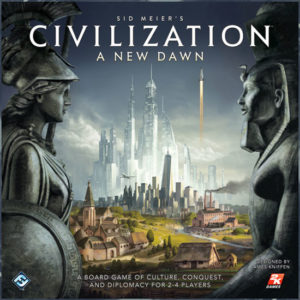 Designing board games is a challenging business. It has the same risk as movie production, albeit at a dramatically smaller scale. However, the need to meet the demands of a taste-specific audience while also attracting a larger audience is still at the core of some types of game design, especially when dealing with an existing piece of intellectual property (IP).
Designing board games is a challenging business. It has the same risk as movie production, albeit at a dramatically smaller scale. However, the need to meet the demands of a taste-specific audience while also attracting a larger audience is still at the core of some types of game design, especially when dealing with an existing piece of intellectual property (IP).
Fantasy Flight Games is certainly no stranger to this and often they’re a company that takes smaller risks. However, with their new release of Sid Meier’s Civilization: A New Dawn (Civ: A New Dawn), they’re bringing more Euro-centric game design to a tried and true brand. This title is a civilization game where players will build cities and develop technology, but on a speed and scale rarely encountered in civilization games.
At heart, Civ: A New Dawn is an action selection, civilization building game for 2-4 players that takes about 30 minutes per player to play. It definitely plays best with 3 or 4 players.
Gameplay Overview:
The main mechanism that diverts Civ: A New Dawn from its forebears is the Focus Row. Five action cards occupy five numbered slots (1-5) in front of each player. On their turn, a player will select a card to activate with the card’s action modified either by the number of the slot or by the terrain type associated with the slot. For example, activating a Science card yields 1 to 5 points of advances in technology. Activating an Economy card allows a player to move a trade caravan as long as they are of certain terrain types that match the action card’s slot or lower.

This essentially creates a type of rondel mechanism where older actions get more powerful. Once a card is used, it returns to the first slot and pushes all other cards to higher slots. Players find that they need to activate almost everything at some point unless they can creatively use their turns to select the actions that will benefit them the most at just the right time.
Additionally, the game comes with several double-sided multi-hex map tiles to create a large and diverse terrain. Besides the landscape, spaces also include neutral city-states, barbarians, and resource spawns. Each of these interacts with the player in a somewhat expected way. A player can send a trade caravan to city-states, conquer the barbarians that harass them, and place control tokens on the board to expand their empire and control resources.
Many of the game’s tasks will provide an additional supply of Trade Goods tokens. These are used to bolster effects from a player’s action cards. Players who are doing well in the game will often have multiple cards with Trade Goods on them.
These activities all have the aim of completing a certain number of objectives. Each game is randomized with three objective cards, each of which has two objectives. A player who completes one objective on each of the three cards wins the game.
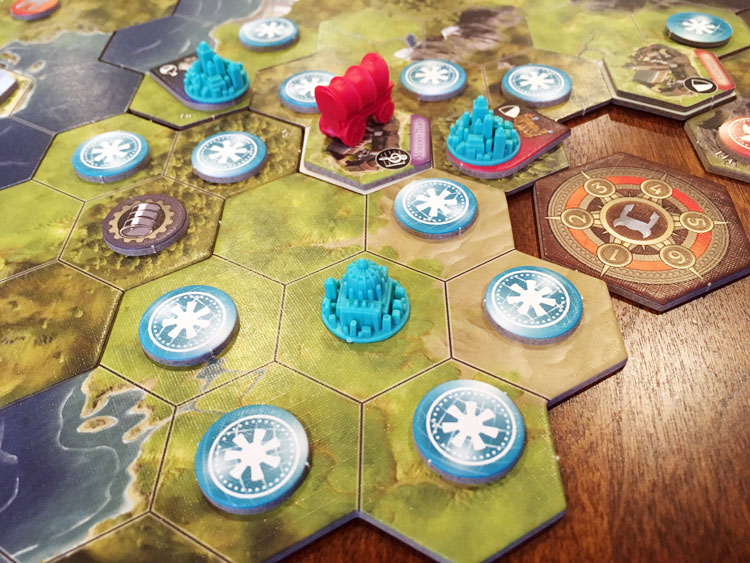
Game Experience:
Many games will often delight reviewers with slightly different mechanisms or a new twist on a theme. Rare is the game that brings a new fresh feeling to a tired genre in both form and function. Sid Meier’s Civilization: A New Dawn does precisely that, but in the process, it abstracts away many thematic elements of civilization building to achieve the goal. Depending on your point of view, this could be very welcome or a bucket of cold water. For this reviewer, this design is refreshingly welcome indeed.
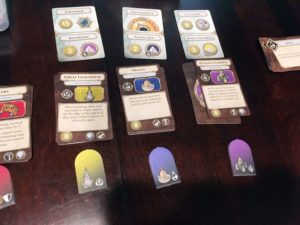
The main brilliance of the design comes from the focus row. This is a mechanism that could have easily been thrown into a heavier game. As it is, Civ: A New Dawn is definitely lighter, but after a full game it can give the feeling a heavier experience took place. This is due to the highly engaging, quick turns. Each action usually requires little in the way of adjustment of components so the pace is quick and “almost” light.
The use of this action card row also results in deep strategic and tactical play. A player can control their overall strategy by using the Science action to upgrade each individual action card. This results in more powerful actions as a player’s civilization gains focus. This also means that making the right choices will determine whether players have the right tools or abilities to complete the game objectives. Atomic actions are also crucial. Players will need to mentally brew plans for actions three turns out.
The other aspect of civilization building that this reviewer enjoys tremendously is seeing a dynamic civilization emerge on the multi-terrain map. The included map tiles give a huge variety and require deep considerations of terrain on almost every turn. The default way to play for this reviewer will be for players to build the map from scratch thereby adding even more fuel to the conflict in the game.
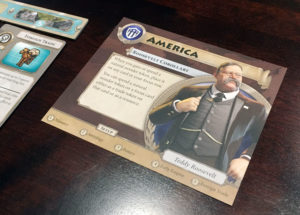
With all this praise, there are some defects. The main one is the level of abstraction required to make the game fit the expected play time and weight of decision-making. It’s hard to call this a defect, but it won’t be uncommon for gamers coming from a civ-building game background to find the mechanisms and units manipulated to be excessively abstracted from reality. There are no phalanxes of centurions or hoplites to hop around the board. Cardboard control tokens represent the advance of a player’s society. Gamers who are cool with that won’t see this as a negative.
What is more annoying is the lack of additional content. There are only five objective cards in the game and eight leaders for civilizations. Aggressive play will consume these quickly. In addition, there’s no way to customize a civilization’s diplomacy options, consisting only of four cards which often leave players disappointed. There are other areas that could be expanded as well, but with the amount of play desired from the game, on the whole, the content available is not generous.
Final Thoughts:
For this reviewer, Sid Meier’s Civilization: A New Dawn wasn’t a stellar hit from the first play. It took a second and third play to really see the awesomeness contained herein. Coming from a non-civilization gaming background, there is nothing missing here and the abstracting isn’t distracting. Civilization: New Dawn is a formidable civilization game which will thoroughly entertain and invite post-game discussion. Mainly, the desire for more of the good stuff to make it replayable is the only thing holding it back.
Final Score: 4.5 Stars – An amazing game that can only get better with expansions. Unfortunately, these are also desperately needed to give life to long-term playability.
 Hits:
Hits:
• Excellent strategic and tactical play
• Fun action selection mechanism
• Quick turns
• True feeling of choice and civilization direction
• Really cool map building
Misses:
• Desperately needs an expansion
• Requires abstraction of civilization mechanisms







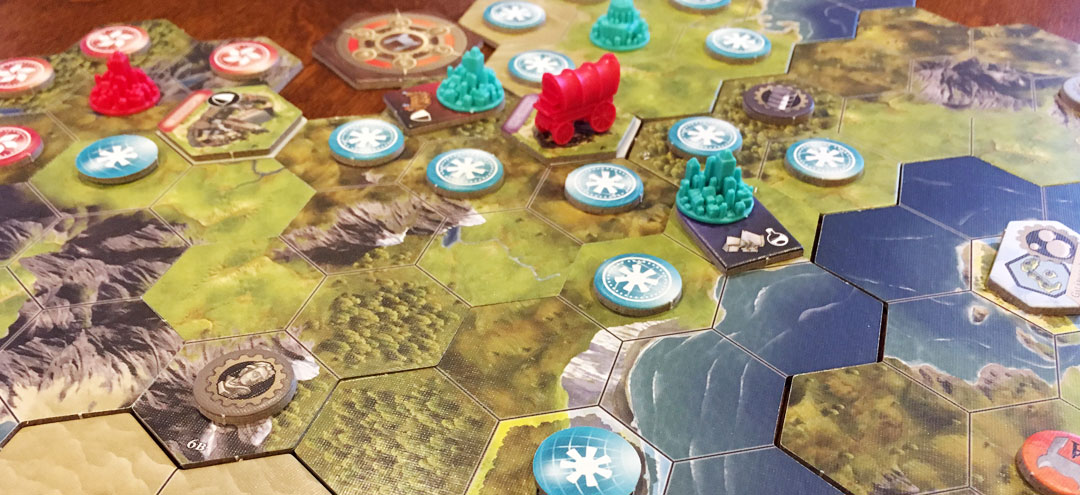















I totally agree with your review. Awesome game if you’re not coming from a civ-building game background. After playing it 15-20 times in 2 years, I really feel like it needs a few expansions. I even started to create them by myself… I like the focus row mecanism, it’s very original and satisfaying. Overall it’s a good game with nice mecanism but slightly too streamlined and desperatly needs one or 2 expansions.
Well, it got an expansion, so why there isn’t a review of it?